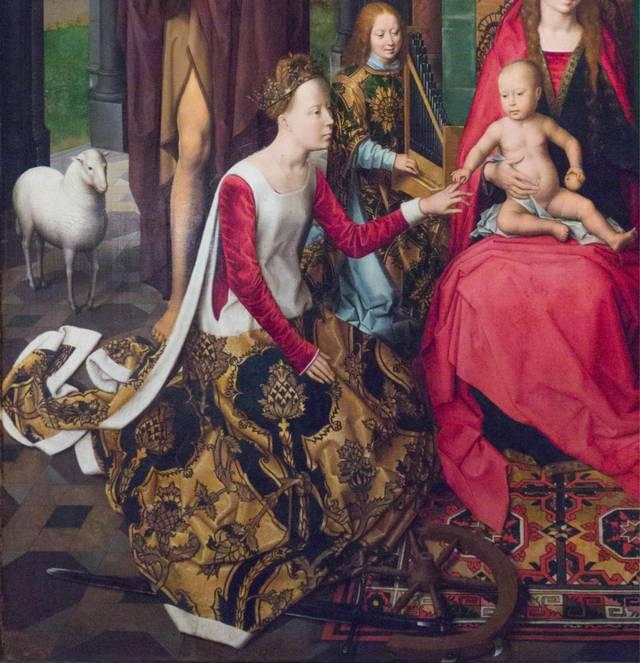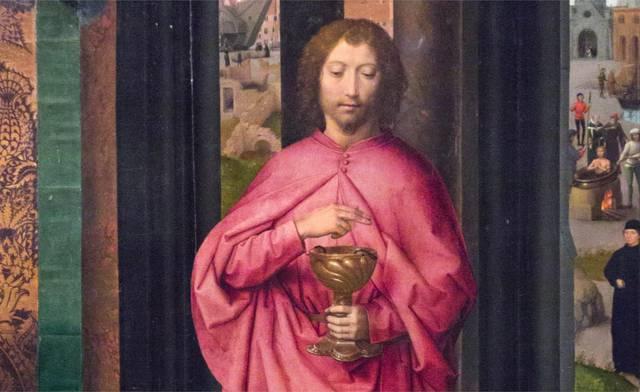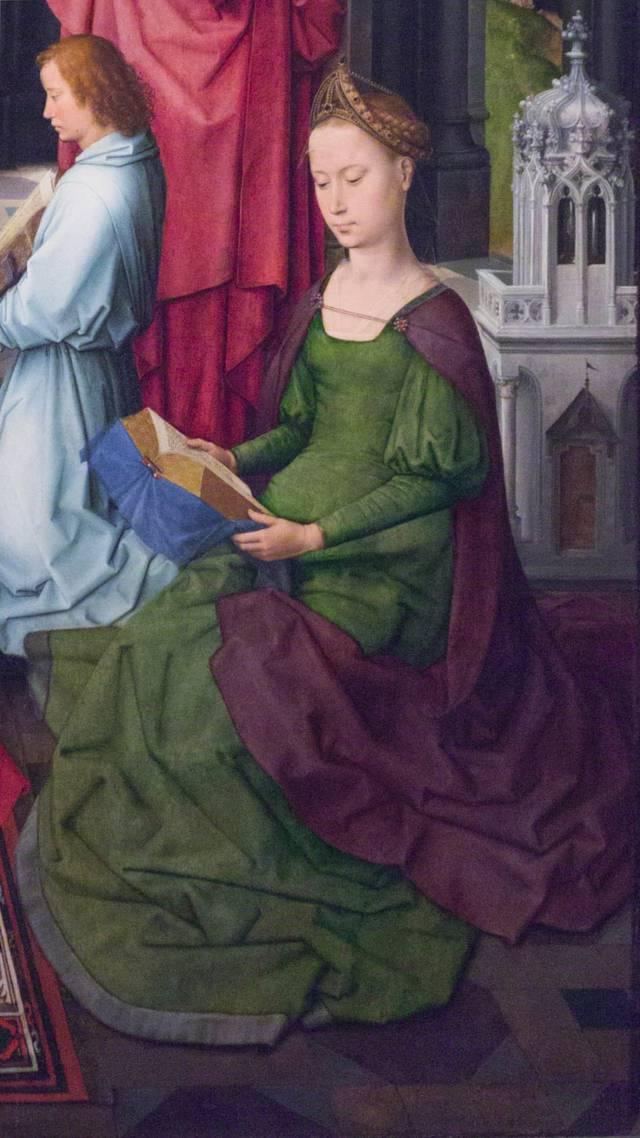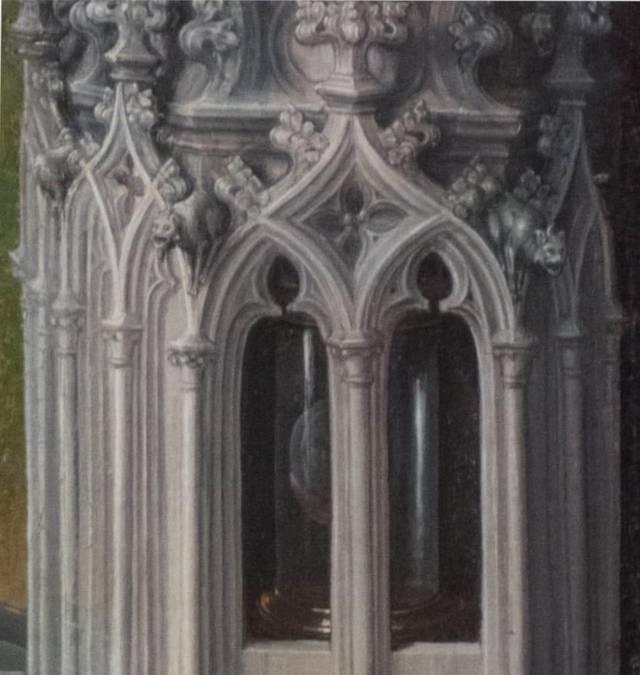catherine of Alexandria
catherine of Alexandria in the scene of then central panel
The sword and the broken wheel at his feet are the instruments of his martyrdom: it is Catherine of Alexandria.

Catherine of Alexandria
Catherine of Alexandria was, since the end of the 13th century, a very popular saint whose legend, reported by Jacobus da Varagine in chapter 168 of The Golden Legend, entitled “Saint Catherine”, is fascinating.
read: text of the Legend of Catherine of Alexandria according to chapter 168 of The Golden Legend.
It is quite likely that Memling relied on this text.
Although modern historians believe that Catherine of Alexandria has not really existed note 2 and her cult was removed from the general calendar of the catholic church in note 3.
catherine of alexandria, her legend in the 15th century
According to her legend, Catherine is a patrician known for her exceptional education and her great beauty
She may have lived in Alexandria in the 3rd or 4th centuries.
She defies the roman emperor of the time, Maxentius, who then threatened christians with public abjuration.
Maxence is surprised by this extraordinary woman, who offends and humiliates him by the relevance of her conversation.
He struggles to maintain his dignity and, defeated at the end of a long spiritual battle full of twists and turns, proposes to her to marry him.
Catherine, in the name of her faith, refused and chose to undergo martyrdom.
At the time of his execution, Jesus' own voice would then have been heard from heaven to tell him:
«Come, my beloved, my beautiful one!»
Due to the presence of Saint Catherine, the triptych has sometimes been called “the mystical marriage of Saint Catherine” note 4.
the two john
two twins: john the baptist, john the evangelist
But more than Catherine of Alexandria, two men are the main characters of the work:
- the many details that tell their two legends throughout the interior of the triptych (central panelm, right and left shutters),
- both are called "John", which, in a hollow way, materializes in the work the commissioning institution, St. John's Hospital in Bruges and justifies the current official name, Triptych of John the Baptist and John the Evangelist.
they stand as twins, standing, right and left, on either side of the virgin, framed, on the back.
john the baptist
On the back, on the left, the presence of a white lamb allows us to identify the man wearing the magnificent purple tunic as John the Baptist.
The lamb recalls the words with whom John the Baptist presents Jesus, saying (John chapter 1 verse 29):
«Behold the lamb of god».
In fact, John also refers with his right arm to the child Jesus.

The lamb is a new symbol of the christian faith.
In contrast to the ancient hebraic faith, where, in order to please god, animals had to be sacrificed to him, christianity affirms that the only true sacrifice that pleases god is that which the believer makes of himself, in imitation of Jesus and in reference to this word of the prophet Isaiah (Isaiah, chapter 53 verset 7):
«afflicted he didn't open his mouth. As a lamb that is led to the slaughter».
Under his purple tunic is another tunic, light brown, which the text tells us is camel hair (Mark chapter 1 verse 6), imitating the hair garment of the prophet Elijah (2 Kings chapter 1 verse 8).
This same hair garment also refers to an episode of Genesis (Genesis chapter 27 verses 1 to 40) during which Jacob, on the advice of his mother Rebecca, poses as his brother Esau who is very hairy, with his blind father, Isaac, by wearing a hair garment.
His cunning allows him to be unduly blessed and thus become the sole heir in Esau's place. This tunic is also a sign of domination of animality, and in the case of John the Baptist, the camel being an animal that allows to cross the desert, of domination of animality by asceticism.
john the evangelist
On the other side, on the right, another man standing, dressed like a priest, in red, makes with his right hand the sign of the cross on a cup, in which there is a serpent: it is John the Evangelist.

We recognize John the Evangelist as an episode of the The Golden Legend (chapter 9), which we report here.
John faces Aristodemus, priest of the temple of Diana in Asia (probably Ephesus), who publicly challenges him to drink a poisoned cup.
The later makes, as Memling represents him, the sign of the cross, drinks the cup but the poison does him no harm.
The serpent also refers to a word that Jesus addressed to Nicodemus (John chapter 3 verses 14 to 15):
“As Moses lifted up the serpent in the wilderness, even so must the Son of Man be lifted up, that whoever believes in him should not perish, but have eternal life.”.
the name «john», its link with the institution, its etymology
the etymology of the name «John» in Hebrew
The etymology of the first name "John" comes from the hebrew «Yokhanan», whose pronunciation is:
which literally means «god» is «grace» or «mercy».
As «god» also means in hebrew «what is», it also means «the one who is» «grace» or «mercy».
Although this first name was used by several minor figures in the history of the hebrew people, it only became very popular after the appearance of christianity in the christian world, following the very important role each of them played, roles that we will soon detail.
Barbara the Great Martyr
Barbara the Great Martyr in the scene of the central panel
On the other side of virgin Mary, on the front right, another woman, dressed in a magnificent green wool tunic as only Bruges produced in the 15th century, reads.
Her presence corresponds to that of Catherine of Alexandria on the front of the other side.
Behind her, a white stone tabernacle tower tells us that it is Barbara the Great Martyr note 5.
As with Catherine of Alexandria, modern historians doubt the reality of her existence and her name has also been removed from the general calendar note 3.

Barbara the Great Martyr, its historical reality
The text Memling relied on to represent her is also not part of The Golden Legend but, like other texts, was added to it later.
read: text of the Legend of Beard the Great Martyr added to The Golden Legend.
Barbara the Great Martyr, her legend in the 15th.
According to his legend, Barbara lives in Nicomedia, capital of the former province of Bithynia, which is located in the north of present-day Turkey and overlooks the Black Sea. Barbara has the defect of being beautiful..., so beautiful, that when he was very young, his father emprisoned her in a tower!
The text teaches us that Barbara then feels «the nothingness of earthly things» and begins to worry about «heavenly things». Although it was forbidden in her time, she gradually turned away from the roman gods and secretly wrote to the most famous christian of Alexandria in Egypt, Origen. The latter replied, fortifying her in her nascent faith, visiting her and secretly giving her the baptism.
Publicly denounced later for refusing to sacrifice to the gods, she was martyred. Jesus' voice would then have been heard from heaven:
«Come, my beloved; rest in my father's house in heaven».
His own father cuts off her head.
the host through the tower of Barbara the Great Martyr
Through the intertwining of the tower, a host appears in a glass cylinder mounted on a golden crescent moon.

The host is one of the attributes of the saint; it is also a link with the rest of the panel that reveals other aspects of it in the form of a «sacred conversation».